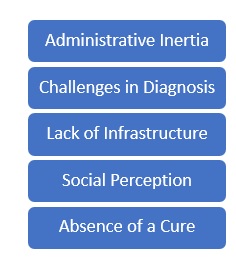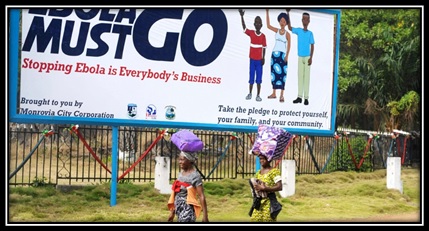Introduction
When figures clad head-to-toe in protective white Tyvek suits, goggles and masks received raving reviews, they weren’t on a space mission. They were on a mission to save humans from a severe and often fatal illness – Ebola Virus Disease or simply referred to as Ebola. The story of Ebola is a tale of tragedy, fear, hope, resistance, we-could-have-done-it-better and triumph. Nonetheless, it is also an inspirational story of those who showed extreme resilience in the face of adversity. They were commonly referred to as ‘Ebola Fighters’ and were named Time’s ‘Person of the Year[i]’ in 2014.
Image 1: The Journey of Triumph
Origin
It is caused by a “hellaciously destructive” virus and was discovered in 1976 with two consecutive outbreaks reported in the Democratic Republic of Congo (DRC) and South Sudan. The nomenclature is attributed to the river Ebola, which flows by the site of the outbreak in the DRC.
The 2016-19 outbreak was the largest since its discovery. The first known case of EDV was reported in a forested area in Guinea called Meliandou in December 2013, wherein a boy named Emile Ouamouno died. This was also followed by a series of deaths in the family of Emile’s sister Philomene and grandmother. Later, it was found that two people who attended the grandmother’s funeral returned to their village of Guéckédou, and infected a health care worker and their own family members. However, it was found much later that the virus is transmitted via direct contact of the body fluids of the afflicted.
Image 2: Details of Ebola Virus Disease
Source: https://www.aljazeera.com/indepth/interactive/2018/05/ebola-virus-disease-180520135930241.html
Challenges
The phase of horror for the West Africa lasted for 920 days i.e. from 2nd December 2013 to 9th June 2016. During this, almost 29,000 people were infected by the deadly virus and more than 11,000 people died. There were many factors responsible for such a high number of casualty.
Image 3: Factors that posed challenges in dealing with the menace
The administrative inertia in dealing with the problem was palpable until the numbers grew exponentially. Dr. Michael Osterholm observes:
“Progress is painfully slow. The virus is operating in virus time, and all of us are operating in bureaucracy time. And the virus is winning, hands down.”
There was a considerable delay in the confirmation of EDV as during the initial days, the patient reported symptoms common to other diseases. These symptoms were mistaken for either a flu or a SARS. As the incubation period ranges from 2-21 days, the extreme symptoms were prominent during the later stage of the disease, which adversely affected the survival rates among the patients.
The exponential rise in Ebola cases exposed the lack of infrastructure in countries such as Liberia. As there were confirmed cases of Ebola, the patients diagnosed with Ebola had to be quarantined in “observation centres” on exhibiting similar symptoms. This consequently exacerbated the problem as unfortunately, there were no places to accommodate more. As the influx spiked, it was beyond the capacity of the health care workers to handle these patients with limited resources. One of the volunteers working during the outbreak recounted that they found themselves “fighting a forest fire with spray bottles.” Also, while comparing The Eternal Love Winning Africa 2 (ELWA 2) Clinic to the “gates of hell”, Dr. Sarah explains the horror she witnessed:
“There are dying patients lying side by side with the deceased that no one has taken care of. There is no room for more people, living or dead. Outside, people are lying under the trees, waiting to be admitted.”
The social landscape had nothing favourable to offer either. As rumours spread like wild fires, speculations began too. Some thought it was an attempt on the part of the government to get funds from international aid groups and the danger wasn’t real. The virus soon acquired a social stigma too. Medical missionaries were viewed with suspicion and those who worked as one were disowned by their families. Threats were common and sometimes, it spiralled out into violence too.
The world of medicine has been apathetic to the excruciating pain of the patients as no vaccine has been developed till now even though EDV was discovered in 1976. Dr. Anthony Fauci, Director of National Institute of Allergy and Infectious Diseases (NIAID), said “the lack of willingness of corporations to make investment risks where there was no market.”
All these factors prompt one to deduce that things could have been better, had initial problems been addressed timely. However, there was hope at the end of the tunnel.
Resistance
The resistance in the Ebola story was not merely a resistance to a mutating, invisible virus; it was also a resistance to a lackadisical government, the ossified social beliefs and death. The health care workers fought in life-threatening conditions to save lives. They witnessed death at close quarters as they were forced to witness gruesome deaths. They dealt with the aftermath too and were the most vulnerable. Some of these health care workers didn’t even belong to the lands they were serving in. Also in the absence of a definite cure, the endeavour was insanely audacious. The origins of the disease were not known. The extent of the outbreak had been growing increasingly. Yet the resistance continued. It ultimately proved to be a remarkable example of death-defying altruism.
Image 4: Health care workers performing the burial of a deceased
Source:https://www.sciencemag.org/news/2017/05/updated-will-vaccine-help-curb-new-ebola-outbreak-drc
It was only known that Ebola patients must be separated from the rest of the hospital population and treated by staff wearing protective gear. However, there was no isolation ward in any hospital of Liberia. Dr. Jerry Brown, a general surgeon, managed to convert a modest chapel into one by convincing the chapel authorities that they were serving the ‘children of God’. ELWA and ELWA 2 were very instrumental in identifying the initial cases.
Contact tracing was followed as another method for identification of symptomatic people. This entailed reaching out to the afflicted and then finding out others in the vicinity who exhibited similar symptoms. This was marred by denial and consequent resistance from locals too. But as the numbers grew exponentially, people rushed to specialised centres.
The government finally swinged to action and understood the magnitude of the problem amidst concerns raised by organisations such as Doctors Without Borders / Médecins Sans Frontières (MSF) and World Health Organisation (WHO). The latter declared it as “a publich health emergency of international importance”. The pressure also mounted as the media reported extensively after the cases were reported beyond Africa. The World Bank pledged $200 million. The Centers for Disease Control and Prevention CDC’s emergency-operations unit swinged into action and the first U.S.- built Ebola Treatment Unit (ETU) went online in November 2014. On 9th of June 2016, West Africa was declared Ebola free by WHO.
Image 5: People celebrating on the streets when Liberia was declared Ebola-Free
Source: https://www.sciencemag.org/news/2016/01/who-declares-ebola-outbreak-over
Conclusion
Image 6: The billboard mentioning a collective action: “Ebola Must Go”.
Source: https://healthcommcapacity.org/technical-areas/ebola/
The horrific tales of Ebola have ended for now. But those that remain now are the stories of resilience and inspiration. This was only possible because of a cross-cutting community-based approach. It entailed engaging with communities, providing safe water, improving sanitation and hygiene, boosting psychosocial support and providing assistance with nutrition.
The Ebola story is a story of inspiration as it reinstates the faith in humanity, which united in the face of a crisis. World organisations, the administration, the community, the society, and individuals all rose to the occasion in a fight against a common, invisible enemy. The win was inevitable.
References
Sifferlin, Alexandra, et al. “TIME Person of the Year 2014: Ebola Fighters.” Time, Time, 10 Dec. 2014, time.com/time-person-of-the-year-ebola-fighters/. Accessed on 25th January 2020.
Quammen, David. “Introduction.” Ebola the Natural and Human History of a Deadly Virus, W.W. Norton & Company, 2014, p. 1.
Bullard, Stephan Gregory. A Day-by-Day Chronicle of the 2013-2016 Ebola Outbreak. Springer, 2019, p.311.
Lyons-Weiler, James. “Introduction.” Ebola: An Evolving Story. World Scientific, 2015, p.vii
Sifferlin, Alexandra, et al. “TIME Person of the Year 2014: Ebola Fighters.” Time, Time, 10 Dec. 2014, time.com/time-person-of-the-year-ebola-fighters/.
[1]Hurum, Lindis. “A Few Days in July.” The Politics of Fear: Médecins sans Frontières and the West African Ebola Epidemic, by Michiel Hofman and Sokhieng Au, 1st ed., Oxford University Press, 2017, pp. 55.
Lyons-Weiler, James. Ebola: An Evolving Story. World Scientific, 2015, p.191.
“Statement on the 1st Meeting of the IHR Emergency Committee on the 2014 Ebola Outbreak in West Africa.” World Health Organization, World Health Organization, 2 Nov. 2014, www.who.int/mediacentre/news/statements/2014/ebola-20140808/en/. Accessed on 25th January 2020.









Recent Comments